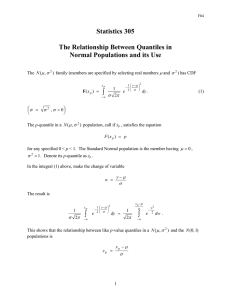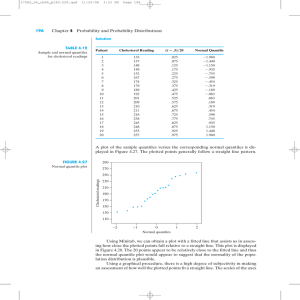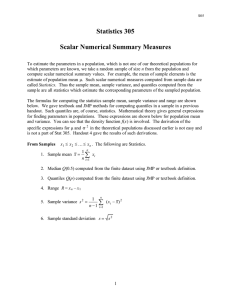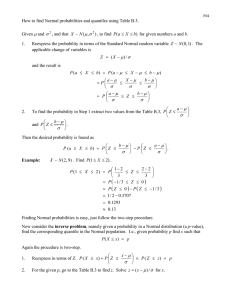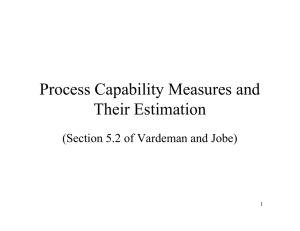Estimating high quantiles for electricity prices by stable linear models
advertisement
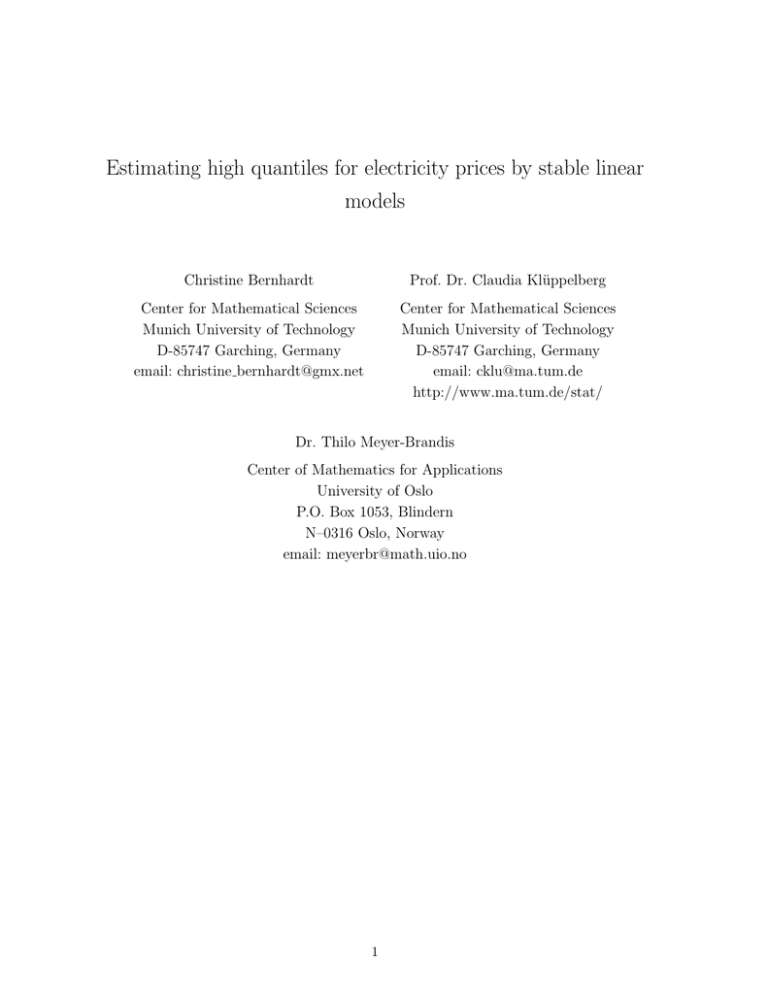
Estimating high quantiles for electricity prices by stable linear
models
Christine Bernhardt
Prof. Dr. Claudia Klüppelberg
Center for Mathematical Sciences
Munich University of Technology
D-85747 Garching, Germany
email: christine bernhardt@gmx.net
Center for Mathematical Sciences
Munich University of Technology
D-85747 Garching, Germany
email: cklu@ma.tum.de
http://www.ma.tum.de/stat/
Dr. Thilo Meyer-Brandis
Center of Mathematics for Applications
University of Oslo
P.O. Box 1053, Blindern
N–0316 Oslo, Norway
email: meyerbr@math.uio.no
1
Abstract
We estimate conditional and unconditional high quantiles for daily electricity spot prices
based on a linear model with stable innovations. This approach captures the impressive peaks
in such data and, as a four-parametric family captures also the assymmetry in the innovations. Moreover, it allows for explicit formulas of quantiles, which can then be calculated
recursively from day to day. We also prove that conditional quantiles of step h ∈ N converge
for h → ∞ to the corresponding unconditional quantiles. The paper is motivated by the
daily spot prices from the Singapore New Electricity Market, which serves an example to
show our method at work.
AMS 2000 Subject Classifications: primary: 60H25
secondary: 60G10, 60J05
Keywords: ARMA model, electricity prices, high quantile, linear model, stable distribution
2
1
Introduction
The liberation of electricity markets requires new models and methods for risk management in
these highly volatile markets. The data exhibit certain features of commodity data as well as
financial data. We summarize the following stylized features of daily electricity prices (see for
example [9] or [14] and references therein).
(a) Seasonal behaviour in yearly, weekly and daily cycles.
(b) Stationary behaviour.
(c) Non-Gaussianity manifested for instance by high kurtosis.
(d) Extreme spikes.
In this paper we shall present statistical estimation of high quantiles, unconditional and
conditional ones. Whereas in [8] we discussed the fit of a continuous-time model aiming at
pricing of electricity spot price derviatives, in this paper we fit a simple discrete-time ARMA
model enriched by a trend and seasonality component. We propose an ARMA-model with stable
innovations, which is able to capture in particular the impressive spikes. Such a model seems to
be appropriate for the estimation of high quantiles aiming at risk management. In this model it
is also straightforward how to estimate high quantiles, conditional as well as unconditional ones.
For the conditional quantiles we present not only the one-step, but also multi-step predicted
quantiles. We also show that when the number of steps increases, the conditional quantiles
converge to the unconditional ones.
Our analysis is motivated by daily spot prices from the Singapore New Electricity Market
available at www.ema.gov.sg as depicted in Figure 1. The data are measured in Singapore-Dollar
per MegaWatthour (SGD/MWh) and run from January 1, 2005 to April 11, 2007, resulting in
n = 831 data points.
Figure 1: Time series plot of the Singapore data (January 2005 - April 2007) (Xt )t=1,...,n for n = 831 data points
b t (in red) as modeled in Section 2.
with estimated seasonality function Λ
3
Our paper is organised as follows. In Section 2 we present the data, which we model by a
deterministic component (capturing trend and seasonality) and a stationary time series. Invoking
classical model selection procedures for linear models we find that a pure AR model does not
capture the features of the data, but an ARMA(1,2) model is suggested. As expected, the
estimated residuals are assymmetric with high positive peaks, and we use a four-parametric
stable model for the innovations. Section 3 is devoted to the quantile estimation, where we
use that the estimated parameters correspond to a causal and invertible model. In Section 3.1
we apply well-known results from stable linear models to estimate the unconditional quantiles,
whereas in Section 3.2 we derive formulas for conditional quantiles, the recursion formulas and
the almost sure convergence result of conditional quantiles to the unconditional ones. Throughout
we use the spot price data for illustration.
2
Data and Model
We model our data as
Xt = Λt + Yt ,
t ∈ Z,
(2.1)
where Λt combines trend and saisonality (yearly and weekly) in the following deterministic model
τ1 + 2πt
τ2 + 2πt
(2.2)
Λt = β0 + β1 cos
+ β2 cos
+ β3 t , t ∈ Z ,
365
7
and (Yt )t∈Z is a stationary ARMA model, which has to be further specified later. We estimate Λ
by a robust least squares method (see [7], Ch. 1) and obtain the following estimated parameters.
βb0
βb1
τb1
βb2
τb2
βb3
103.66
-13.13
2136.16
-0.7686
32.04
0.04597
Table 1: Estimates of the parameters of (2.2)
Figures 1 and 2 show the original time series with estimated seasonality function and the
deseasonalised series, respectively.
b t for t = 1, . . . , n. Then we test (Ybt )t=1,...,n for stationarity by an
Define now Ybt = Xt − Λ
augmented Dickey-Fuller test and a Phillips-Perron test (cf. [1], Ch. 4, for details). Both tests
result in a p-value less than 0.01. We want, however, remark that our data are heavy-tailed,
in particular, as we shall see below, they have infinite variance. Consequently, variance and
autocorrelation function do not exist. It has, however, been shown in [5] that empirical variance
and autocorrelations converge to a stable vector. This means that the empirical quantities make
still sense, but the confidence bands are much wider. See also [6], Section 7.3. Having clarified
this, we assume stationarity for (Yt )t∈Z in (2.1).
In the same spirit we fit an ARMA model of appropriate order based on the empirical
autocorrelation and partial autocorrelation function in Figure 3; cf. [3], Ch. 3.
4
Figure 2: Deseasonalised series (Ybt )t=1,...,n .
Figure 3: Empirical autocorrelation function and empirical partial autocorrelation function of the desaisonalised
time series (Ybt )t=1,...,n .
Moreover, we use the AICC and BIC criterions for all ARMA(p, q) models with p + q ≤ 3;
the result is depicted in Figure 4; cf. [4], Section 5.5 for such criterions. From this it is obvious
that a simple AR model is not sufficient to model the data properly. The best model with
respect to both criterions was an ARMA(1, 2) for (Yt )t∈Z ; i.e. with Y0 = 0 and iid (Zt )t∈Z whose
distribution we will specify later,
Yt = φ1 Yt−1 + Zt + θ1 Zt−1 + θ2 Zt−2 ,
t ∈ Z.
(2.3)
bt )t=1,...,n clarifies two points.
An explorative analysis of the residuals (Z
(1) The empirical autocorrelation function of the residuals and of the squared residuals shows
no significant dependence; cf. Figure 5. This implies that a linear model is appropriate for
these data and more sophisticated models as suggested in Swider and Weber [13] are not
necessary.
(2) Figure 6 shows that the distribution of the residuals is highly non-symmetric and has a
bt )t=1,...,n is shown in the left plot
heavy right tail. The empirical distribution function of (Z
5
Figure 4: Values of the AICC and BIC criterions for the ARMA(p, q) model with p + q ≤ 3 for the deseasonalised
time series (Ybt )t=1,...,n
ARMA(1, 2)
c1
φ
θb1
θb2
0.930
(0.879 , 0.980)
-0.689
(-0.776 , -0.602)
-0.123
(-0.197 , -0.0489)
Table 2: MLEs of the ARMA(1, 2) coefficients with 95%-confidence intervals for the deseasonalised time series
(Ybt )t=1,...,n
of Figure 7. The right plot shows the mean excess plot; i.e. the empirical counterpart of
e(u) = E(X − u | X > u) ,
u ≥ 0.
The increase of the estimated mean excess function shows clearly that the right tail is
Pareto like. As is confirmed by a Hill plot, the corresponding tail index is clearly smaller
than 2.
For definitions and notation we refer to Embrechts et al. [6], Ch. 6 and Resnick [12], Section 4.
This tail pattern, in combination with the asymmetry, indicates that a four-parameter stable
distribution is an appropriate model for the residuals (Zt )t∈Z . It is defined as follows.
Definition 2.1 (Stable random variable, stable distribution). A random variable Z has an
α-stable distribution with index of stability α ∈ (0, 2], skewness parameter β ∈ [−1, 1], scale
bt )t=1,...,n and the squared residuals (Z
bt2 )t=1,...,n .
Figure 5: Plot of the autocorrelation functions of the residuals (Z
6
bt )t=1,...,n .
Figure 6: Plot of the residuals (Z
bt )t=1,...,n . Right: Mean excess plot of the positive residuals.
Figure 7: Left: Plot of the histogram of the residuals (Z
parameter γ > 0, and location parameter δ ∈ R, if
γ V − β tan πα + δ,
d
2
Z=
γV + δ,
α 6= 1,
α = 1,
where V is a random variable with characteristic function
exp −|t|α 1 − iβ tan πα (sign t) ,
2
itV
ϕV (t) = Ee =
exp −|t| 1 + iβ 2 (sign t) log (|t|) ,
π
α 6= 1,
α = 1.
The sign function sign t is defined as usual: sign t = −1, 0, 1 according as t < 0, t = 0, t > 0,
respectively.
We denote the class of stable distributions by S(α, β, γ, δ). A random variable Z ∼ S(α, β, γ, δ)
is also referred to as α-stable.
If δ = 0 and γ = 1 the distribution is called standardized α-stable.
7
For more information on stable distributions we refer to [11] or any other monograph on
stable distributions. The advantage of choosing a stable model lies in the fact that stable distributions are closed with respect to linear transformations. The following result can be found in
[11], Section 1.6.
Theorem 2.2. Let (Xj )j∈N0 be iid S(α, β, γ, δ) distributed random variables and (ψj )j∈N0 a
P
real-valued sequence with j |ψj |α < ∞. Then
∞
X
ψj Xj ∼ S α, β, γ, δ ,
j=0
with
β = β
γ = γ
∞
X
α
|ψj | sign (ψj )
j=0
∞
X
∞
X
|ψj |α
−1
,
j=0
|ψj |α
1
α
,
j=0
∞
∞
P
P
πα
,
β
γ
−
βγ
ψ
δ
ψ
+
tan
j
j
2
j=0
j=0
δ =
∞
∞
P
P
2
ψj +
β γ log (γ) − βγ
ψj log |ψj γ| ,
δ
π
j=0
j=0
α 6= 1,
α = 1.
Various estimation procedures have been proposed in the literature. In this paper we use
bt )t=1,...,n .
MLE, which gives the following parameter estimates for the residuals (Z
ML-estimators
α
b
βb
γ
b
δb
1.282650
0.442722
7.012304
-7.610320
bt )t=1,...,n .
Table 3: MLEs of the parameters α, β, γ and δ of the stable distribution for the residuals (Z
Again one may ask for asymptotic properties of these estimators as the usual regularity
conditions on the model to guarantee asymptotic normality are not satisfied. It has, however,
been shown in [10] that MLEs for heavy-tailed models have even better rate of convergence than
models with finite variance.
3
Estimating high quantiles
After having fitted an appropriate model to our data we now turn to the estimation of high
quantiles, where we present unconditional as well as conditional ones. Recall the model from
(2.3)
Yt = φ1 Yt−1 + Zt + θ1 Zt−1 + θ2 Zt−2 ,
t ∈ Z,
b γ
where (Zt )t∈Z are iid S(α, β, γ, δ) with estimators α
b, β,
b and δb given in Table 3.
We shall invoke the following result.
8
(3.1)
Proposition 3.1 ([3], Proposition 12.5.2). Let (Zt )t∈Z be iid S(α, β, γ, δ) distributed. Denote
by θ(z) = 1 + θ1 z + · · · + θ1 z q and by φ(z) = 1 − φ1 z − · · · − φp z p , and assume that φ(z) 6= 0
for |z| ≤ 1. Then the difference equations φ (B) Yt = θ (B) Zt for t ∈ Z (B denotes the backshift
operator) have the unique strictly stationary and causal solution
Yt =
∞
X
ψj Zt−j ,
t ∈ Z,
(3.2)
j=0
where the coefficients (ψj )j∈Z are chosen so that ψj = 0 for j < 0 and
∞
X
ψj z j =
j=0
θ(z)
,
φ(z)
|z| ≤ 1 .
(3.3)
If in addition φ(z) and φ(z) have no common zeroes, then the process (Yt )t∈Z is invertible if and
only if θ(z) 6= 0 for |z| ≤ 1. In that case
Zt =
∞
X
πj Yt−j ,
t ∈ Z,
(3.4)
j=0
where the coefficients (πj )j∈Z are chosen so that ψj = 0 for j < 0 and
∞
X
πj z j =
j=0
φ(z)
,
θ(z)
|z| ≤ 1 .
(3.5)
Note that with the estimated coefficients of Table 2 the model (3.1) is causal and invertible.
Invoking (3.3) and (3.5) gives the following parameters ψ and π for an ARMA(1,2) model as
functions of the model parameters φ1 , θ1 , θ2
ψj
1
=
θ1 + φ1
θ2 φj−2 + θ1 φj−1 + φj
1
πj
1
1
=
−θ1 − φ1
−θ2 πj−2 − θ1 πj−1
1
for j = 0,
for j = 1,
(3.6)
for j ≥ 2 ,
for j = 0,
for j = 1,
(3.7)
for j ≥ 2 .
In our situation, the parameters ψ are given by (3.6). In order to compute the unconditional
quantiles, we then plug in the MLEs for φ1 , θ1 , θ2 , which results in ψbj as presented in Table 4.
3.1
Unconditional quantiles
For q ∈ (0, 1) and t ∈ Z the unconditional q-quantile of Xt is defined as the generalised inverse
of its distribution function; i.e.
xq (t) := inf{x ∈ R : P (Xt ≤ x) ≥ q} .
9
ψb0
ψb1
ψb2
ψb3
ψb4
ψb5
ψb6
1
0.241
0.101
0.094
0.087
0.081
0.081 × 0.930
b1 = 0.930 (cf. Table 2).
Table 4: Estimates for ψj for 0 ≤ j ≤ 5; their rate of decrease is given by φ
The unconditional quantiles of Yt and Zt are defined analogously, and denoted by yq (t) and
zq (t). First note that, by definition (2.1) of the model, the quantiles of Xt and Yt are linked by
for q ∈ (0, 1) , t ∈ Z .
xq (t) = Λt + yq (t) ,
In order to estimate the quantile of Xt , it suffices thus to estimate the quantile of Yt . By
stationarity and causality of Y , the unconditional quantile yq (t) = yq becomes independent of t
and can be expressed as
∞
n
X
o
yq := inf y ∈ R : P
ψj Zt−j ≤ y ≥ q ,
q ∈ (0, 1) .
j=0
Using Theorem 2.2, the following result in order to compute unconditional quantiles is derived
in [2].
Theorem 3.2. Assume model (3.2) with (Zj )j∈N0 iid S(α, β, γ, δ) distributed. For q ∈ (0, 1)
denote by sq the q-quantile of an S α, β, 1, 0 distributed random variable. Then the q-quantile
yq is given by
q ∈ (0, 1) .
(3.8)
yq = γ sq + δ ,
The parameters β, γ und δ are given by
β = β
γ = γ
∞
X
∞
X
ψjα sign(ψj )
j=0
∞
X
|ψj |α
−1
,
j=0
|ψj |α
1/α
,
j=0
δ =
P
∞
δ j=0 ψj + tan
πα
2
β γ − βγ
∞
P
ψj ,
α 6= 1 ,
j=0
∞
∞
P
P
2
ψj +
β γ log (γ) − βγ
ψj log |ψj γ| ,
δ
π
j=0
j=0
α
b
b
β
b
γ
b
δ
1.282650
0.442722
13.20421
-15.19818
α = 1.
bt )t=1,...,n .)
Table 5: Estimates for α, β, γ and δ as in Theorem 3.2 (for the residuals (Z
The quantiles of the corresponding stable distribution for appropriate high levels are presented in Table 6.
From this and (3.8) we obtain the corresponding estimated unconditional quantiles ybq of the
stationary random variable Ybt as given in Table 7.
10
q
0.95
0.99
0.999
sbq
5.309276
17.50723
102.0260
b 1, 0) distributed random variable.
Table 6: 95%-, 99%- and 99.9% quantiles of a S(b
α, β,
q
0.95
0.99
0.999
ybq
54.9066
215.9709
1331.974
number of exceedances
44
5
0
Table 7: 95%-, 99%- and 99.9% quantiles of the stationary time series (Ybt )t=1,...,n with simple backtesting procedure, counting the number of exceedances of the estimated quantiles (44=5.3%, 5=0.6% of data).
Figure 8: Time series (Ybt )t=1,...,n with 95%- and 99% quantile (the 99.9% quantile is outside of the figure).
Figure 9: Data (Xt )t=1,...,n with 95%- and 99% quantile (the 99.9% quantile is outside of the figure).
11
3.2
Conditional quantiles
For q ∈ (0, 1) the conditional q-quantile of Xt of step h, where t ∈ Z and h ∈ N, is defined as
the generalised inverse of its conditional distribution function, conditioned on the observation
of the time series (Xt )t∈Z up to time t − h:
n
o
xhq (t) := inf x ∈ R : P Xt ≤ x | Xs , s ≤ t − h ≥ q .
Note that by definition (2.1), the observation sigma algebra generated by {Xs , s ≤ t − h} is the
same as the one generated by {Ys , s ≤ t − h}. Therefore, provided we know Λt we can express
the conditional q-quantile of Xt as
xhq (t) = Λt + yqh (t) ,
where
n
o
yqh (t) := inf y ∈ R : P Yt ≤ y | Ys , s ≤ t − h ≥ q
is the conditional q-quantile of Yt of step h, conditioned on the evolution of the time series
(Yt )t∈Z up to time t − h.
Theorem 3.3. Assume a causal and invertible model of the form (3.2) with (Z
j )j∈N0 iid
h
S(α, β, γ, δ) distributed. For q ∈ (0, 1) and h ∈ N denote by sq the q-quantile of an S α, β h , 1, 0
distributed random variable. Then the conditional q-quantile yqh (t) of step h is given by
∞
X
yqh (t) = γ h shq + δ h +
q ∈ (0, 1) , h ∈ N .
ψj Zt−j ,
(3.9)
j=h
The parameters β h , γ h und δ h are given by
βh = β
h−1
X
h−1
X
−1
ψjα sign(ψj )
|ψj |α
,
j=0
γh = γ
h−1
X
j=0
|ψj |α
1/α
,
j=0
δh
=
h−1
P
ψj + tan
δ
δ
j=0
h−1
P
j=0
ψj +
πα
2
β γ − βγ
h−1
P
ψj ,
j=0
h−1
P
2
β γ log (γ) − βγ
ψj log |ψj γ| ,
π
j=0
Note that by the invertibility of the model, the term
∞
P
α 6= 1 ,
α = 1.
ψj Zt−j in (3.9) is known in the
j=h
sense that it is measurable with respect to the sigma algebra generated by {Ys , s ≤ t − h}.
12
Proof. Using the causality and invertibility of the model, we get
∞
X
P (Yt ≤ y | Ys , s ≤ t − h) = P (
ψj Zt−j ≤ y | Ys , s ≤ t − h)
j=0
h−1
X
= P(
ψj Zt−j ≤ y −
j=0
h−1
X
= P(
∞
X
ψj Zt−j | Zs , s ≤ t − h)
j=h
ψj Zt−j ≤ y − u)
j=0
u=
∞
P
ψj Zt−j
,
j=h
where we have used the independence of the innovations Zt in the last equality. We thus have
h−1
P
to compute the unconditional q-quantile of
ψj Zt−j , which as in Theorem 3.2 with ψj = 0 for
j=0
all j ≥ h is given by
proved.
γh
shq
+
δh.
The conditional quantile (3.9) then follows and the theorem is
The following result is a contribution to the discussion about conditional versus unconditional
quantiles.
Corollary 3.4. For every t ∈ Z, the following almost sure convergence holds
h→∞
yqh (t) −→ yq
a.s..
Proof. Comparing Theorems 3.2 and 3.3, from the definition of the parameters we have for
h → ∞ the following convergence: γ h → γ, δ h → δ, and β h → β. From the characteristic
function (2.4) one then easily infers that shq → sq and, consequently, (γ h shq + δ h ) → (γ sq + δ) for
∞
P
h→∞
h → ∞. Further, by assumption of causality of the model as in (3.2), the sum
ψj Zt−j −→ 0
j=h
almost surely. This proves the corollary.
For computational purposes, in the relevant situation of our ARMA(1,2) model, it is useful
to note the following formulation of the conditional quantile.
Corollary 3.5. Let (Yt )t∈Z be the solution of a causal and invertible ARMA(1, 2) model as given
in (3.1), whose innovations (Zt )t∈Z are iid S(α, β, γ, δ) distributed. Then yqh (t), the conditional
q-quantile of step h at time t, is given by
y 1 (t) = γ h s1 + δ h + φ Y
for q ∈ (0, 1) , h = 1 ,
1 t−1 + θ1 Zt−1 + θ2 Zt−2
q
q
y h (t) = γ h sh + δ h + φh Y
+ (φh−1 θ + φh−2 θ )Z
+ φh−1 θ Z
for q ∈ (0, 1) , h ≥ 2 .
q
1 t−h
q
1
1
1
2
and
δh
t−h
1
2 t−h−1
(3.10)
Here, the quantile
shq
and the parameters
γh
are as in Theorem 3.3.
Proof. From (3.6) it follows that
ψh+1
φ1 ψh + θ1
= φ1 ψh + θ2
φ1 ψ
h
13
for h = 0 ,
for h = 1 ,
for h ≥ 2 ,
(3.11)
and we get
∞
X
ψj Zt−j =
j=h
By (3.2) we have
∞
P
h
ψj Zt−h−j + θ1 Zt−h + θ2 Zt−h−1
φ1
φh1
∞
P
j=0
∞
P
j=0
for h = 1 ,
ψj Zt−h−j + (φh−1
θ1 + φh−2
θ2 )Zt−h + φh−1
θ2 Zt−h−1
1
2
1
for h ≥ 2 .
ψj Zt−h−j = Yt−h , which proves the Corollary.
j=0
Once we have computed the first conditional quantile, we can use the following recursive
relation for the computation of further quantiles.
Lemma 3.6. The conditional q-quantile yqh (t + 1) at time t + 1 can be expressed in terms of the
conditional q-quantile yqh (t) at time t as follows:
y 1 (t + 1) = (1 − φ )(γ h s1 + δ h ) + φ y 1 (t) + ψ Z + θ Z
1 q
1 t
2 t−1 for h = 1 ,
1
q
q
y h (t + 1) = (1 − φ )(γ h sh + δ h ) + φ y h (t) + ψ Z
for h ≥ 2 ,
1
q
1 q
q
h
t+1−h
where by the model specification (3.1), Zt+1−h is obtained recursively in terms of the observed
Yt+1−h , Yt−h and previous innovations Zt−h , Zt−1−h as
Zt+1−h = Yt+1−h − φ1 Yt−h − θ1 Zt−h − θ2 Zt−1−h .
Proof. We have, using the form (3.9) of the conditional quantile, that
yqh (t
+ 1)
=γ h shq
+
δh
+
=γ h shq + δ h +
∞
X
j=h
∞
X
ψj Zt+1−j
ψj Zt−j +
j=h
∞
X
ψj (Zt+1−j − Zt−j )
j=h
=yqh (t) + ψh Zt+1−h +
∞
X
(ψj+1 − ψj )Zt−j .
j=h
Invoking (3.11) we get for h = 1
∞
X
(ψj+1 − ψj )Zt−j =(φ1 − 1)
j=1
∞
X
ψj Zt−j + θ2 Zt−1
j=1
=(φ1 − 1)(yqh (t) − γ h s1q − δ h ) + θ2 Zt−1 ,
and for h ≥ 2
∞
X
(ψj+1 − ψj )Zt−j =(φ1 − 1)
j=h
∞
X
ψj Zt−j
j=h
=(φ1 − 1)(yqh (t) − γ h shq − δ h ) .
Substituting in (3.12) yields the result.
14
(3.12)
We now consider the estimated conditional quantiles ybq1 (t) of step h = 1 of our data, assuming
that Λ(t) is known for all t ≥ 0. To this end we plug in the estimated parameters φb1 , θb1 , θb2 and
bt in (3.10) and obtain
residuals Z
bt−1 + θb2 Z
bt−2 ,
ybq1 (t) = s1q + φb1 Yt−1 + θb1 Z
(3.13)
bγ
b distributed random variable. The estimates Z
bt are
where s1q is the q-quantile of a S(b
α, β,
b, δ)
obtained via the invertibility of the model (cf. Proposition 3.1) and are given by
bs :=
Z
∞
X
π
bj Ys−j ,
s ∈ Z.
j=0
Here the estimates π
bj are constructed by plugging in φb1 , θb1 , θb2 in (3.7). Note that after computing (3.13) once, we can use Lemma 3.6 to determine the conditional quantiles recursively for
the next time steps.
The conditional quantiles for q = 0.95 and q = 0.99 can be seen in figure 10.
Figure 10: Conditional quantiles for q = 0.95 and q = 0.99. Top: stationary time series, bottom: original data.
For a simple backtesting procedure we count the number of exceedances of the estimated quantiles. There are 57
exceedances for the 95%-quantile and 11 for the 99%-quantile. Thus both quantiles are underestimated.
15
Acknowledgement
We thank Peter Brockwell for providing us with a version of the program ITSM, which extends
a student version to be found on a CD in [4]. Apart from this we have also used the statistics
program R, available at www.r-project.org.
References
[1] Banerjee A., Dolado J.J., Galbraith J.W. and Hendry, D.F. (1993) Cointegration, Error
Correction, and the Econometric Analysis of Non-Stationary Data. Oxford University Press,
Oxford.
[2] Bernhardt, C. (2007) Modellierung von Elektrizitätspreisen durch lineare Zeitreihenmodelle
Diploma Thesis, Munich University of Technology.
[3] Brockwell, P. and Davis, R.A. (1991) Time Series: Theory and Methods. Springer, New
York.
[4] Brockwell, P.J. and Davis, R.A. (1996) Introduction to Time Series and Forecasting.
Springer, New York.
[5] Davis, R.A. and Resnick, S.I. (1986) Limit theory for the sample covariance and correlation
functions of moving averages. Ann. Statist. 14, 533-338.
[6] Embrechts, P., Klüppelberg, C. and Mikosch, T. (1997) Modelling Extremal Events for
Insurance and Finance. Springer, Berlin.
[7] Huber, P.J. (1981) Robust Statistics. Wiley, New Jersey.
[8] Klüppelberg, C., Mayer-Brandis, T. and Schmidt, A. (2007) Electricity spot price modelling
with a view towards extreme spike risk. In preparation.
[9] Meyer-Brandis, T. and Tankov, P. (2007) Statistical features of electricity prices: evidence
from European energy exchanges. Preprint.
[10] Mikosch, T., Gadrich, T., Klüppelberg, C. and Adler, R. (1995) Parameter estimation for
ARMA models with infinite variance innovations. Ann. Statist. 23, 305-326.
[11] Nolan (2007) Stable Distributions – Models for Heavy Tailed Data. Birkhäuser, Boston. In
preparation. Chapter 1 available at www.academic2.american.edu/∼jpnolan.
[12] Resnick, S.I. (2007) Heavy-Tail Phenomena: Probabilistic and Statistical Modeling. Springer,
New York.
[13] Swider, D.J. and Weber, C. (2007) Extended ARMA-models for estimating price developments on day-ahead electricity markets. Electric Power Systems Research 77, 583-593.
16
[14] Weron R. (2006) Modeling and Forecasting Electricity Loads and Prices: A Statistical Approach. Wiley Finance Series.
17
